Consumer behavior is a fascinating area of study that explores how people make decisions about purchasing products and services. Here are some of the best books on consumer behavior I have read, and recommend.
“Thinking, Fast and Slow” by Daniel Kahneman
This book explores the two systems of thinking that people use when making decisions and how these systems influence consumer behavior.
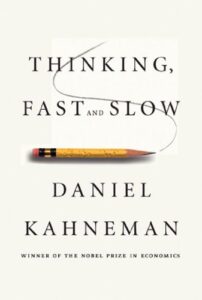

“Thinking, Fast and Slow” is written by Nobel Prize-winning economist and psychologist Daniel Kahneman, and is clearly the first in my list. The book explores the two modes of thinking that influence our decision-making processes: the fast and intuitive “System 1” and the slower, more analytical “System 2”. Kahneman argues that our reliance on System 1 thinking can lead to cognitive biases and errors in judgment and that we must learn to use System 2 thinking to counteract these biases.
The book is divided into five parts, each of which explores a different aspect of human decision-making.
The first part introduces the concept of System 1 and System 2 thinking, and how these modes of thinking influence our perception of the world.
The second part focuses on the cognitive biases that result from our reliance on System 1 thinking, such as the availability bias and the representativeness bias.
The third part explores the limitations of intuition and the importance of data-driven decision-making.
The fourth part of the book examines the role of emotions in decision-making and the impact of decision-framing on our choices.
The final part of the book discusses the implications of Kahneman’s research for public policy and business decision-making. “Thinking, Fast and Slow” is a fascinating and thought-provoking book that challenges readers to question their own decision-making processes and to adopt a more analytical approach to problem-solving.
By shedding light on the biases and errors inherent in human thinking, Kahneman’s work has had a profound impact on the fields of economics, psychology, and decision theory.
“Influence: The Psychology of Persuasion” by Robert B. Cialdini:
This classic book explores the principles of persuasion and how they are used in marketing and advertising.
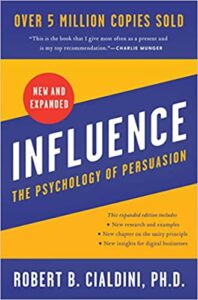
The book was written by psychologist Robert B. Cialdini who examines the psychological principles behind successful persuasion and influence. The book outlines six principles of persuasion, including reciprocity, social proof, authority, consistency, liking, and scarcity. Cialdini argues that these principles are fundamental to successful persuasion and are commonly used in marketing, advertising, and other forms of influence.
The first part of the book introduces the concept of persuasion and sets out the six principles of influence. Cialdini provides examples of each principle in action, using real-world scenarios to illustrate how the principles are used to influence behavior. The second part of the book explores the psychology behind these principles, examining the cognitive biases that make us susceptible to persuasion and the strategies that successful persuaders use to overcome resistance.
The book is written in an engaging and accessible style, making it easy for readers to understand and apply the principles of persuasion in their own lives. By understanding the psychological principles that underlie persuasion, readers can become more aware of the techniques used by persuaders and can make more informed decisions about when to resist or give in to influence. Overall, “Influence: The Psychology of Persuasion” is a fascinating and insightful book that is essential reading for anyone interested in the science of persuasion and influence.
“Buyology: Truth and Lies About Why We Buy” by Martin Lindstrom
This book uses neuroscience and psychology to explore the factors that influence consumer behavior and decision-making.
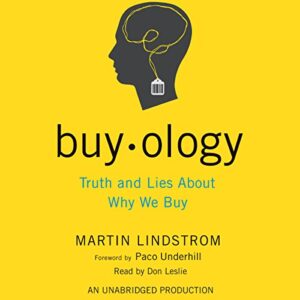
Written by marketing expert Martin Lindstrom, the book examines the neuroscience behind consumer behavior. The book draws on Lindstrom’s extensive research using brain-scanning technology to explore the subconscious drivers of consumer behavior. The book challenges many of the assumptions and myths about advertising and marketing and offers insights into the underlying motivations that drive consumer behavior.
The book explores different aspects of consumer behavior, such as the role of emotion, the impact of branding, and the power of subliminal messages. Lindstrom presents a range of case studies and experiments to illustrate his points, drawing on examples from a variety of industries. He also provides practical advice for marketers and advertisers, based on his research, on how to create more effective advertising campaigns that resonate with consumers on a subconscious level.
Overall, “Buyology” is a fascinating and thought-provoking book that sheds light on the complex relationship between advertising and the human brain.
By using cutting-edge neuroscience research, Lindstrom challenges many of the assumptions and myths about advertising and offers a new perspective on the underlying drivers of consumer behavior. The book is essential reading for anyone interested in marketing, advertising, or consumer behavior, and offers practical insights that can be applied in a variety of contexts.
“Predictably Irrational: The Hidden Forces That Shape Our Decisions” by Dan Ariely
This book explores how emotions and cognitive biases influence consumer behavior and decision-making.
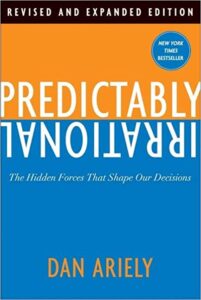
“Predictably Irrational: The Hidden Forces That Shape Our Decisions” is written by behavioral economist Dan Ariely, and explores the irrationality inherent in human decision-making. Ariely argues that our decisions are influenced by a range of cognitive biases and heuristics that can lead us to make predictable mistakes. The book is divided into chapters that explore different aspects of human behavior, such as the impact of social norms, the power of expectations, and the role of emotions in decision-making.
The book draws on a range of experiments and studies to illustrate its points, and Ariely uses a range of real-world examples to demonstrate how the principles of behavioral economics apply in everyday life. The book is written in an engaging and accessible style, making it easy for readers to understand and apply the concepts presented.
Overall, “Predictably Irrational” is an insightful book that challenges readers to question their own decision-making processes. By shedding light on the cognitive biases and heuristics that influence our behavior,
Ariely offers practical advice on how to make more informed decisions and avoid the pitfalls of irrational thinking. The book is essential reading for anyone interested in behavioral economics, psychology, or decision-making, and offers valuable insights that can be applied in a variety of contexts.
“Consumer Behavior: Buying, Having, and Being” by Michael R. Solomon
This textbook provides a comprehensive overview of consumer behavior, covering topics such as motivation, perception, and social influences on behavior.
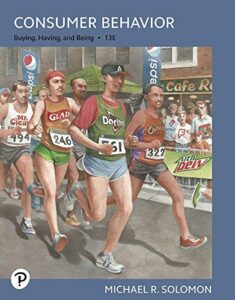
I had to include a college textbook in this list. “Consumer Behavior: Buying, Having, and Being” is a comprehensive textbook written by marketing expert Michael R. Solomon. The book offers a thorough examination of the factors that influence consumer behavior, drawing on a range of theories and research studies to provide a comprehensive overview of the field. The book is divided into three sections that explore the processes of buying, having, and being, and offers practical insights into how marketers can use this understanding to create effective marketing campaigns.
The first section of the book focuses on the buying process, exploring the factors that influence consumers’ decision-making, including the role of social influence, perception, and learning. The second section of the book examines the concept of ownership, exploring the psychological and social meanings of possessions, and how they relate to identity and self-expression. The final section of the book looks at the concept of being, exploring the role of consumption in shaping consumers’ sense of self, and the ways in which consumers use products to create and communicate their identities.
Overall, “Consumer Behavior: Buying, Having, and Being” is an essential resource for anyone interested in the field of consumer behavior. The book is written in an engaging and accessible style, making it easy for readers to understand the concepts presented.
By providing a comprehensive overview of the field, the textbook offers valuable insights that can be applied in a variety of contexts, making it a must-read for marketers, researchers, and students alike.
“The Power of Habit: Why We Do What We Do in Life and Business” by Charles Duhigg
This book explores the role of habits in consumer behavior and how businesses can use this knowledge to influence behavior.
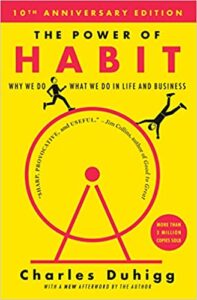
Written by Pulitzer Prize-winning journalist Charles Duhigg, “The Power of Habit: Why We Do What We Do in Life and Business” is a book that examines the science behind habits and how they influence our daily lives. The book is divided into three sections that explore the psychological, social, and neuroscientific aspects of habits. Through a series of engaging stories and case studies, Duhigg provides practical insights into how habits are formed, how they can be changed, and how they can be used to achieve personal and professional success.
The first section of the book focuses on the psychology of habits, exploring the habit loop and how it drives our behavior. Duhigg provides examples of how habits have shaped the lives of individuals and organizations, from the success of Olympic gold medalists to the transformation of Alcoa’s corporate culture.
The second section of the book examines the social aspect of habits, exploring how they are influenced by our social networks and the power of peer pressure. Duhigg provides examples of how social movements, such as the civil rights movement, have been driven by the power of habits and how social networks can be used to promote positive change.
The final section of the book looks at the neuroscientific aspects of habits, exploring how they are formed and how they can be changed. Duhigg provides practical advice on how to identify and modify habits, offering insights into how individuals and organizations can use this knowledge to achieve personal and professional success. Overall, “The Power of Habit” is a thought-provoking and informative book that sheds light on the complex interplay between habits and human behavior. The book is essential reading for anyone interested in personal development, organizational behavior, or the science of habits.
“Hooked: How to Build Habit-Forming Products” by Nir Eyal
This book provides insights into how businesses can create products and services that form habits in consumers, leading to increased customer loyalty and engagement.
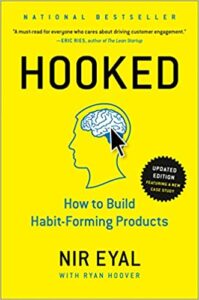
A no-miss for any entrepreneur or product manager, “Hooked: How to Build Habit-Forming Products” is a book written by entrepreneur Nir Eyal that explores the science behind building products that can create and sustain user habits. The book is divided into four sections that explore the four steps of the “Hook Model”: trigger, action, variable reward, and investment. Through a series of real-world examples and case studies, Eyal provides practical insights into how companies can use the Hook Model to create products that users will engage with and return to again and again.
The first section of the book focuses on triggers, exploring the different types of triggers that can initiate user behavior. Eyal explains the importance of understanding users’ internal and external triggers, and how companies can use these triggers to encourage user engagement. The second section of the book examines the action phase, exploring the importance of designing products that are easy to use and require minimal effort from users. Eyal provides practical tips on how companies can reduce friction and increase the likelihood of user engagement.
The third section of the book looks at the variable reward phase, exploring the importance of providing users with rewards that are both satisfying and unpredictable. Eyal provides examples of how companies can use variable rewards to create a sense of anticipation and excitement, encouraging users to return to the product again and again. The final section of the book focuses on investment, exploring how companies can use users’ investment in a product to create a sense of loyalty and commitment. Overall, “Hooked” is a valuable resource for entrepreneurs, product managers, and marketers who want to understand the psychology behind habit-forming products and learn how to build products that users will love and return to time and time again.

Leave a Reply